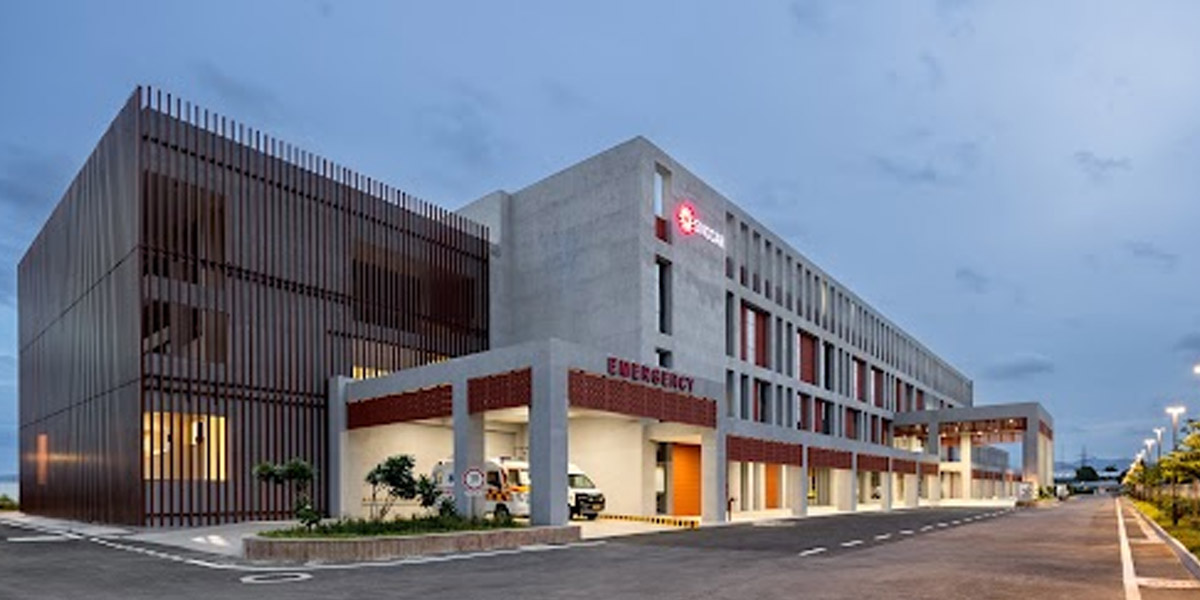In the current scenario, especially close on the heels of the COVID-19 pandemic, there is a need for a radical shift from traditional hospital designs to cater to India’s evolving healthcare needs. Research conducted by the Indian Council of Medical Research estimates that there will be nearly 30 million cancer patients in India by 2025. In response to this growing concern, distributed models of cancer-care centres are being designed across the country. In a recent survey, 70 per cent of respondents felt that flexibility is an essential aspect of good design in healthcare spaces. The replicable design of scalable hospital modules in India emphasises upon the potential of such services in future. The prototypical planning of such scalable modules is designed to create a sense of spatial similarity throughout all upcoming cancer-care centre modules in India, which ensures a cohesive and familiar environment for patients and healthcare providers and allows for future expansions. Edifice Consultants, in collaboration with Tata Trusts, executed the Sri Venkateswara Institute of Cancer Care and Advanced Research in Tirupati, one of the first scalable hospital modules in India.
R SRINIVASAN spoke to
Chinmay Patil, Vertical Head - Medical Planning & Interiors, Edifice Consultants, to know more.
What are scalable hospitals?
Scalable hospital design can adapt, shift function and modify in response to patient care and employee needs. A scalable oncology hospital model is strategically designed to facilitate cancer care that can start small and grow with demand in a planned and efficient manner. With a strong commitment to sustainability, the design of the scalable module demonstrates contextual awareness and deep respect for the surrounding environment.
What was the reason behind choosing this design concept?
The design at Tirupati follows the same form and programme as other prototypes of its scale. Though the building follows the same architectural expression, the uniqueness lies in the design response to the site access, road network, climatic orientation and future phasing. The development is being envisaged in two phases. In case of service demand, a seamless addition of building blocks from L2 to L1 is ensured. Phase 1 would be an L2-A typology consisting of supporting facilities. The facility and master plan for Phase 2 will
be designed to cater to the L1 typology if and whenever the necessity arises.
Has this model been replicated in other cities? A similar facility has been operationalised in Ranchi this year and another has been set up in Chandrapur and is under execution through partnerships of Tata Trusts with other stakeholders. This would probably be the first time that a philanthropic organisation has developed cancer-care centres of such varying scale across the country. Through collaboration with Tata Trusts, our role at Edifice Consultants was to improve cancer-care infrastructure in India by delivering high-quality healthcare facilities that are designed to accommodate scalability, efficiency and patient well-being.
What were the design challenges and how were they overcome?
Hospitals in general are complex buildings and oncology hospitals are highly equipment-intensive. So, the design challenge lies in making equipment virtually invisible so that it doesn’t affect the psyche of patients and instead reduces their anxiety levels to provide them with an environment of hope and healing. Another challenge for this project in Tirupati was managing project execution despite the COVID lockdown. In spite of all these challenges, the project has taken shape due to the
sheer perseverance of all the stakeholders involved.
What is the difference,
cost-wise, between this and conventional structures?
Hospitals being service and equipment-specific come with higher associated costs. For example, a linear accelerator is equipped inside a bunker of concrete walls and ceilings that are as thick as 8 ft in some locations. This is a major cost as the bunker spreads over 1,500 sq ft. As per the code, even the rest of the structural design for a healthcare facility needs to be 1.5 times greater than other building typologies to withstand natural calamities
like earthquakes and continue to serve patients.
Is sustainable infrastructure
more expensive than
normal infrastructure?
There is a misconception about cost escalations in implementing sustainable and environment-friendly design and construction. Contrary to popular belief, cost-efficiency and minimal cost increase can be achieved if the integration of sustainable practices and strategies is conceived during the design stage itself. However, it is essential to note that the cost analysis needs to be analysed on savings provided by strategies in operational costs and in relation to capital expenditure as well. Using natural light and building orientation to benefit the overall optimisation should be prioritised.
What sustainable elements have been incorporated into the structure’s design?
The hospital’s architecture along with material selection plays an important role in contributing to the physical and psychological well-being of patients. Additionally, it houses essential medical equipment and building services, which are high on energy and, at times, water consumption, increasing the operating costs. One of the best strategies to minimise heat intake into the rectangular building lies in using the ideal climatic orientation of the hospital. The longer face of the building is where there are maximum windows, allowing for better light and helping to reduce the HVAC cost. The AC and medical equipment need electricity so climatological orientation is extremely important to reduce both capital and operational expenditure. A design that improves indoor air quality, provides access to abundance of natural light in patient areas and has implemented energy management through smart building management systems (BMS) along with utilisation of materials inherent to the region contributes to sustainable design of the hospital building, which ultimately contributes to a patient’s well-being.
Another element in the sustainability angle is our working with an 80/20 principle wherein 80 per cent of the things remain the same. So, 80 per cent of the look, feel and interiors are the same. Even the rooms are the same across facilities and across cities. Because of the similar planning across sites, if doctors moves from one city to another city for a surgery, say Tirupati and Ranchi, the operation theatres are the same and they are at ease as they know the space and can fully concentrate on doing their work; it is just a change of location, not a change in the working environment. The 20 per cent is the flex built into the design of interior spaces to bring in regional elements, maybe through artwork, a particular flooring tile or a colour specific to that region. Also, this procurement of local materials contributes to a much lower carbon footprint. So, when we designed the facility’s facade, we chose white and a terracotta colour to merge with the local environment. Solar power is provided as a default in all our buildings along with water-efficient fixtures.
Some environment-friendly construction elements and
materials include:
Use of good overhang designs to protect against heat ingress
Use of double-glazing units (DGUs) to reduce the impact
of heat and external noise through windows
Use of fly-ash bricks with high thermal resistance
Use of high solar-reflective index (SRI) paints and light colours in exteriors and interiors to assist in reflection of heat
Use of insulation to support heat management through the roof
Use of energy-efficient
light fixtures.
Also apart from effective navigation for patients or relatives, a clear corridor width of 8 ft across the facility and a mandated 5-ft distance between beds in a ward are guidelines laid down by the National Accreditation Board for Hospitals and Healthcare Providers (NABH) that must be considered diligently for effective planning.
In the building, we also look at how users are going to perform. Most of the time, we speak about patients but forget that there are people who come to work day in and out. We look at facilities for patients who may be there for
a few days but caregivers will be there for 365 days. So, we should create an environment or architecture that is equally comforting for them so that they can concentrate on serving patients. This approach improves the healthcare delivery process; that is how our architecture basically responds to these specific needs.
Please comment on the role of the latest technologies in healthcare.
With ageing infrastructure and increased demand for more beds, it is essential to optimise inpatient and outpatient settings and integrate digital technologies like telemedicine, AI, robotics, precision medicine, genomics, Internet of Medical Things (IoMT), electronic medical record (EMR) and cloud computing into traditional services. Even in the pre-COVID era, digitisation was considered the best way to transform healthcare practices; the pandemic has led us to prioritise patient-centric remote monitoring solutions.
The way ahead
In future facilities, we need to consider how to build flexibly to manage the sudden influx of patients, which was a major challenge during the pandemic. Public healthcare systems must focus on design that quickly converts regular beds to crucial care beds during emergencies.
To support the future health workforce and meet the medical challenges of our times, our healthcare systems should navigate a holistic approach. Now, in India, a majority of the population depends on the public healthcare system while the private healthcare sector provides the majority of secondary and tertiary care in metros and Tier 1 2 cities. Thus, an innovative long-term partnership between the public and private healthcare sectors can bring about a significant change in the system. The Indian Green Building Council (IGBC) places a lot of importance on indoor air quality of hospitals. So, architects and developers must capture these complexities of healthcare design and accordingly ensure maximum inclusion of natural light and ventilation to have an impact on healthcare facilities built in upcoming years, as precursors of positivity, wellbeing and health.


















